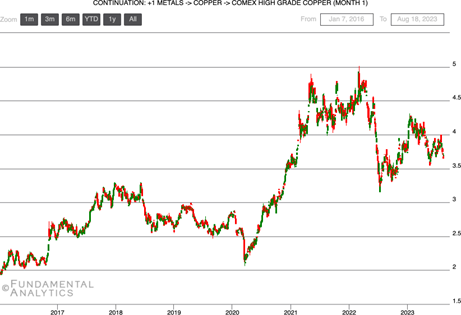Dr. Ken Rietz
August 23, 2023
Copper, left outside, develops a greenish coat, called verdigris, from the old French for ‘green of Greece’. But that isn’t the sense I mean for ‘green’ here. Green can also refer to lush and verdant vegetation, as in the title of Richard Llewellyn’s book How Green Was My Valley (and the movie of the same name). You might have guessed that the book title was the inspiration of the title of this commentary. But ‘green’, in a more modern sense, refers to environmentally safe. This is not unrelated to the novel, which is about a family living in a Welsh mining valley. Their discussion of the growth of the slag pits from the processed output of the mines parallels how ‘green’ our copper is, a measure of the environmental impact of mining and refining our copper. As copper becomes an ever-more-important component of a carbon-free society, measuring and mitigating the carbon footprint of copper, while keeping the price within an affordable range, becomes a question for consideration. We start with the current price of copper.
Figure 1: Spot price of copper in US dollars per pound

The International Energy Agency (IEA) estimates that we will need three times as much copper in 2040 than in 2020. Why the increase? Because the IEA is very concerned about getting to Net-Zero carbon emissions by 2050. This will require many changes, and in particular, more copper. Consider Electric Vehicles (EVs). A standard gasoline-powered car uses about 45 pounds of copper. A typical EV will use up to 175 pounds of copper, roughly four times as much. Or consider power generation. A standard fossil-fuel generation plant uses roughly one ton of copper for every megawatt of power generated. A wind-powered generation system uses roughly 5.5 tons of copper for every megawatt of power. Solar power generation uses the same amount. So, although these numbers are approximations, the estimate from the IEA is at least reasonable.
Mining copper is very energy intensive because the concentration of copper in most ore is quite small, so a large amount has to be excavated to process the amount of copper needed. The country that produces the most copper is Chile, and the copper industry is by far the largest consumer of energy and producer of greenhouse gases (GHG). As the ore with the highest concentration of copper is excavated, even more ore will need to be extracted to keep Chile’s production of copper at the present level. That same trend is true throughout the world. A Yale University study predicts that by 2050, the world will use nearly all of the Ultimately Recoverable Copper and processing that copper will use between 1% and 2.4% (depending on which of four scenarios occurs) of the world’s energy, as opposed to its 0.3% current usage. The battle between producing more copper and reducing GHG at the same time, while ironic, has no simple resolution. The one thing we can be sure of is that the price of copper will increase, probably significantly.
The price of copper in the far future is not easily estimated, but we can look at what is happening with low-carbon copper right now. While several US companies are looking to manufacture low- carbon copper, the major producer of low-carbon copper in Europe is Boliden. Using hydro-power and its own mines, it produces copper at 1.5 tons of CO2 for each ton of copper and sells it to companies that are eager to reduce their carbon footprint. Since all prices of copper are based on a premium (surcharge) of the London Metal Exchange price, that premium becomes the measure of price. Europe’s largest copper smelter charges a premium of $228 per tonne, starting January 1, 2023, a rise of 85% to take advantage of the Russian sanctions. Copper from Boliden is used by companies making various items with a premium around $285 per tonne. As other companies enter the low-carbon copper market, particularly in the US, this premium could drop.